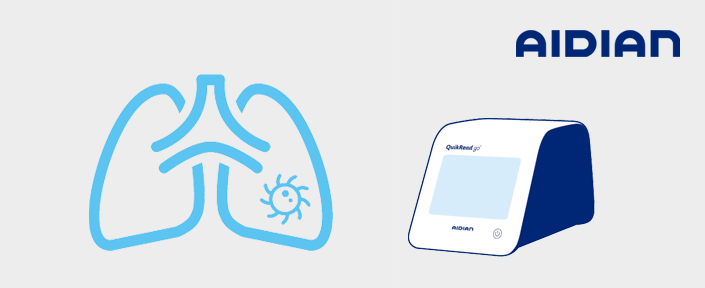CRP and pulmonary findings correlate in COVID-19
Products are for professional/laboratory use only. C-reative protein (CRP) increases during COVID-19 infection, and higher concentrations are often related to the severity of the disease. The result combined with clinical findings helps to assess the severity of the patient’s condition and decide on further steps. CRP is measured fast and easily with the portable QuikRead go CRP system.
A significant increase of C-reactive protein (CRP) has been reported with concentrations on average 30-50 mg/L1,2,3 from patients with COVID-19. It seems that the patients with severe disease symptoms have significantly higher CRP levels. For example a study reported, patients with mild symptoms had on average CRP level of 19 mg/L and patients with more severe symptoms CRP level of 39 mg/L1.
f
The pulmonary findings from CT scans of COVID-19 patients are similar to H1N1 influenza4. In both viral pneumonias CRP level correlates with the severity of pathological findings significantly. The severity of lung CT findings in COVID-19 is also associated with the disease progression5,6. Lung lesions are also more commonly seen in patients aged > 45 years compared to patients < 18 years7. Furthermore, patients with low oxygen saturation (SpO2 < 90%) had significantly higher CRP median (82 mg/L) compared to patients with oxygen saturation SpO2 > 90% (median 11 mg/L)8, suggesting that patients with more severe lung damage have higher CRP values. In conclusion, CRP correlates well with the severity of the symptoms of patients with COVID-19 and therefore it is suitable in assessing patient´s condition together with other clinical findings.
Practical experiences from the COVID-19 pandemic
Efficient patient flow is important when the healthcare system faces exceptionally high numbers of patients with symptoms of any seasonal respiratory pathogen. CRP doesn’t specify the pathogen, but it has been used and recommended as one of the key markers to evaluate the severity of infection, prognostics, and monitoring the course of COVID-19 disease6-8. Measured easily at the forefront, point of care CRP is helping to direct patients to the appropriate treatment path e.g., home care of specific testing7-8.
QuikRead go CRP tests give quick support:
- Fast – 2 minutes test time, thus supporting fast patient flow at the point of care.
- Flexible – 2 hours sample stability, minimum hands-on time and portable instrument support flexible testing in various healthcare settings.
- Reliable – Comparability to clinical chemistry analysers and enhanced bi-directional connectivity features ensure reliable results at the point of care.
- Easy to use – Only a fingerprick blood sample is needed. Maintenance-free instrument with intuitive user interface.
References:
- Gao et al. 2020 Diagnostic Utility of Clinical Laboratory Data Determinations for Patients with the Severe COVID-19. J Med Virol. 2020 Mar 17. doi: 10.1002/jmv.25770.
- Chen et al. 2020. Epidemiological and clinical characteristics of 99 cases of 2019 novel coronavirus pneumonia in Wuhan, China: a descriptive study. Lancet 2020; 395: 507–13. https://doi.org/10.1016/S0140-6736(20)30211-7
- Mo et al. 2020. Clinical characteristics of refractory COVID-19 pneumonia in Wuhan, China. Clin Infect Dis. 2020 Mar 16. doi: 10.1093/cid/ciaa270.
- Feng et al. The relationship between pulmonary HRCT _ndings and peripheral blood immunological parameters in adults with H1N1 in2uenza. Radiology of Infectious Diseases 2016; 3:60-65.
- Song F, Shi N, Shan F, et al. Emerging coronavirus 2019-nCoV pneumonia. Radiology 2020 Feb 6 [Epub ahead of print]
- Pan Y, Guan H, Zhou S, et al. Initial CT _ndings and temporal changes in patients with the novel coronavirus pneumonia (2019-nCoV): a study of 63 patients in Wuhan, China. Eur Radiol 2020 Feb 13.
- Chen et al. High-resolution computed tomography manifestations of COVID-19 infections in patients of diKerent ages. European Journal of Radiology. 24.3.2020. DOI:https://doi.org/10.1016/j.ejra… et al. Clinical Features of 69 Cases with Coronavirus Disease 2019 in Wuhan, China. Clin Infect Dis. 2020 Mar16. doi: 10.1093/cid/ciaa272.







